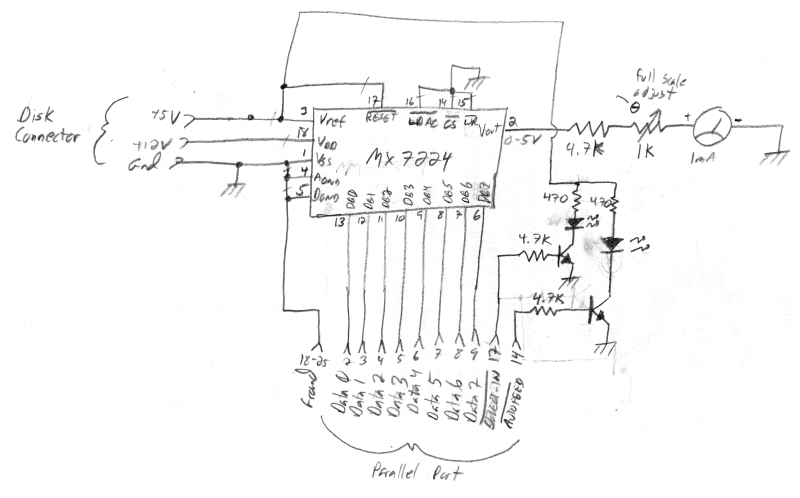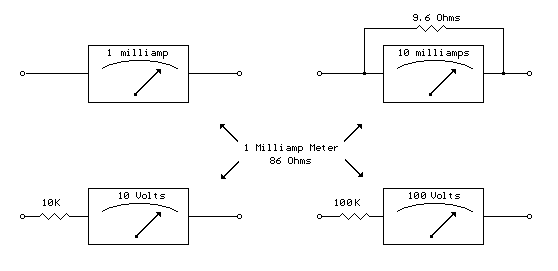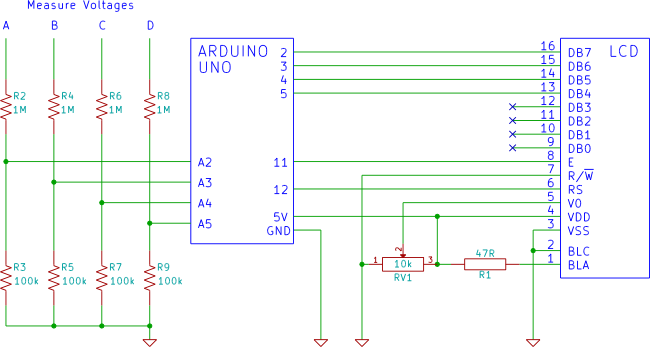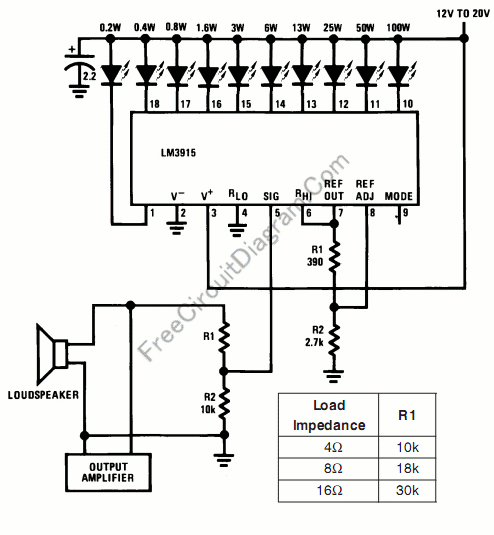
Network Bandwidth Meter

The meter was acquired from eBay and features a full-scale movement of 1 mA, already marked from 0 to 100. The original scale was removed, scanned, and modified to include "% NETWORK" markings using an image editor. The new scale was printed and affixed over the original one. The circuit employs a simple design utilizing a Maxim MX7224 8-bit D/A converter, with digital inputs connected directly to the parallel port. Power and reference voltage are sourced from a disk drive connector. The schematic is available. The circuit is constructed on a piece of perfboard and attached to the back of the meter. While the circuit is not critical, caution is advised to prevent shorts, as PC power supplies can deliver 30 amps or more, which can damage the meter movement and cause insulation to burn off thin wire without the supply recognizing a fault. The MX7224 is a CMOS chip, necessitating precautions against static discharge during handling, and a grounded soldering iron should be used if the chip is not socketed. Possible enhancements include utilizing the MX7224's latch lines for driving multiple meters from a single port or enabling printer pass-through. An antique wood-cased meter housing this circuit would create an appealing external version; the MX7224 can output up to 5 mA, and an emitter follower may be employed to increase current for meters requiring more. The software consists of a basic C program for bit manipulation and a Perl program to calculate bandwidth usage from netstat output, both tailored for FreeBSD. In theory, it may be feasible to execute all functions through Perl, but employing non-standard ioctls in Perl is complex.
The described circuit design integrates a Maxim MX7224 8-bit digital-to-analog (D/A) converter, which is essential for converting digital signals from a parallel port into corresponding analog voltages. This conversion is crucial for applications where real-time monitoring or control of analog devices is required. The digital inputs are directly interfaced with the parallel port, allowing for straightforward integration with a computer system, facilitating easy data transfer and control.
Powering the circuit from a disk drive connector ensures compatibility with common PC hardware, while the use of perfboard for circuit assembly provides flexibility in layout and design. However, careful attention must be paid to avoid shorts, especially given the high current capabilities of typical PC power supplies. This precaution is vital to prevent catastrophic failure of the meter movement, which could occur almost instantaneously under high current conditions.
The MX7224's CMOS technology implies a sensitivity to electrostatic discharge (ESD); therefore, proper handling and grounding techniques are necessary to maintain the integrity of the device. The suggestion of using latch lines for driving multiple meters indicates a potential for scalability in the design, allowing for expanded functionality without the need for additional parallel ports.
The proposed enhancements, such as utilizing an emitter follower to increase output current, demonstrate an understanding of the requirements of various meter types that may require more than the standard output current provided by the MX7224. This adaptability ensures that the circuit can be tailored to meet specific application needs.
The software component, comprising both a C program and a Perl script, highlights the importance of software-hardware integration in modern electronic designs. The C program's role in manipulating digital signals complements the hardware design, while the Perl script’s function of analyzing bandwidth usage indicates a comprehensive approach to system monitoring and performance evaluation.
Overall, this circuit represents a blend of practical electronic design and software integration, suitable for various applications in monitoring and control systems. The aesthetic consideration of housing the circuit in an antique meter adds a unique visual appeal, merging functionality with vintage design.The meter came from eBay, and has a 1 mA full scale movement. It was already marked 0 to 100. I simply removed the original scale, scanned it, and added the "% NETWORK" markings over some of the original ones with an image editor. I then printed the new scale and glued it over the old one. The circuit is a simple design using a Maxim MX7224 8-bit D/A converter, with the digital inputs driven directly by the parallel port. Power and reference voltage come from a disk drive connector. The schematic is available here. I built the circuit on a piece of perfboard and affixed it to the back of the meter. There`s nothing critical about the circuit, but be particularly careful to avoid shorts. PC power supplies can source 30 amps or more. This will destroy a meter movement in an instant, and smoke the insulation right off thin wire without the supply even recognizing a fault. The MX7224 is a CMOS chip, so use some precautions to avoid static discharge while handling it, and use a grounded soldering iron if you don`t socket the chip.
Possible refinements would include using the MX7224`s latch lines to allow driving multiple meters off one port, or to allow a printer pass-through. An antique wood-cased meter with this circuit built inside would make a lovely external version; the MX7224 can source up to 5 mA, and an emitter follower could be used to boost the current for meters that need more.
The software includes a simple C program to do the actual bit-twiddling, and a Perl program to calcuate the bandwidth usage from netstat`s output. These are both pretty FreeBSD-specific. It should, in theory, be possible to do everything from Perl, but using non-standard ioctls from Perl isn`t easy.
🔗 External reference
The described circuit design integrates a Maxim MX7224 8-bit digital-to-analog (D/A) converter, which is essential for converting digital signals from a parallel port into corresponding analog voltages. This conversion is crucial for applications where real-time monitoring or control of analog devices is required. The digital inputs are directly interfaced with the parallel port, allowing for straightforward integration with a computer system, facilitating easy data transfer and control.
Powering the circuit from a disk drive connector ensures compatibility with common PC hardware, while the use of perfboard for circuit assembly provides flexibility in layout and design. However, careful attention must be paid to avoid shorts, especially given the high current capabilities of typical PC power supplies. This precaution is vital to prevent catastrophic failure of the meter movement, which could occur almost instantaneously under high current conditions.
The MX7224's CMOS technology implies a sensitivity to electrostatic discharge (ESD); therefore, proper handling and grounding techniques are necessary to maintain the integrity of the device. The suggestion of using latch lines for driving multiple meters indicates a potential for scalability in the design, allowing for expanded functionality without the need for additional parallel ports.
The proposed enhancements, such as utilizing an emitter follower to increase output current, demonstrate an understanding of the requirements of various meter types that may require more than the standard output current provided by the MX7224. This adaptability ensures that the circuit can be tailored to meet specific application needs.
The software component, comprising both a C program and a Perl script, highlights the importance of software-hardware integration in modern electronic designs. The C program's role in manipulating digital signals complements the hardware design, while the Perl script’s function of analyzing bandwidth usage indicates a comprehensive approach to system monitoring and performance evaluation.
Overall, this circuit represents a blend of practical electronic design and software integration, suitable for various applications in monitoring and control systems. The aesthetic consideration of housing the circuit in an antique meter adds a unique visual appeal, merging functionality with vintage design.The meter came from eBay, and has a 1 mA full scale movement. It was already marked 0 to 100. I simply removed the original scale, scanned it, and added the "% NETWORK" markings over some of the original ones with an image editor. I then printed the new scale and glued it over the old one. The circuit is a simple design using a Maxim MX7224 8-bit D/A converter, with the digital inputs driven directly by the parallel port. Power and reference voltage come from a disk drive connector. The schematic is available here. I built the circuit on a piece of perfboard and affixed it to the back of the meter. There`s nothing critical about the circuit, but be particularly careful to avoid shorts. PC power supplies can source 30 amps or more. This will destroy a meter movement in an instant, and smoke the insulation right off thin wire without the supply even recognizing a fault. The MX7224 is a CMOS chip, so use some precautions to avoid static discharge while handling it, and use a grounded soldering iron if you don`t socket the chip.
Possible refinements would include using the MX7224`s latch lines to allow driving multiple meters off one port, or to allow a printer pass-through. An antique wood-cased meter with this circuit built inside would make a lovely external version; the MX7224 can source up to 5 mA, and an emitter follower could be used to boost the current for meters that need more.
The software includes a simple C program to do the actual bit-twiddling, and a Perl program to calcuate the bandwidth usage from netstat`s output. These are both pretty FreeBSD-specific. It should, in theory, be possible to do everything from Perl, but using non-standard ioctls from Perl isn`t easy.
🔗 External reference





